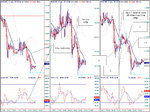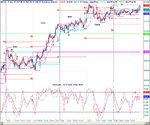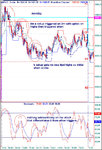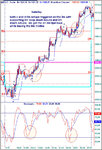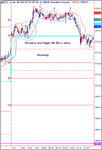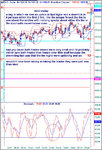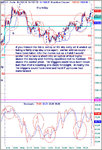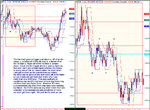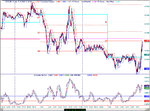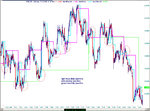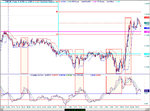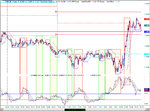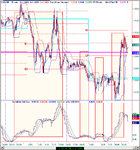Dear Eduardo,
First off don't worry about the RZ averages they're just an illustration, the answers don't lie in the indicators themselves. An RZ or 5 period simple moving average, or any average or indicator can be used to make or lose money. So if you don't have access to these that's ok other tools will do it's really method that counts. And my apologies for my personal lingo it's primarily UGT but I've also adopted many abreviated terms and symbols, don't worry about them hardly anyone does understand them.
Eduardo one of the first things I would want a person to grasp is risk and that it's very real. To me personally this not only extends to my individual trade risk of death by a thousand cuts but overall risk in leverage and that I should understand that leveraging 50k or 500k in a trade carries with it two very different event risk possibilities that even though are remote still exist. And this event risk is not reflected in the margin where for 5 grand and an unforseen circumstance could put a person in fairly deep water. But this is up to the individual . In my eyes 5 mini fx contracts "roughly" equal 1 emini S&P or 1 emini Russell 2000 contract not only in the obvious size but in trading profit potential relative to volatility and is sufficient in the beginning if traded well. I know there are numerous rule of thumb calculations but for me risk needs to be heartfelt, it's like quitting smoking either you want to quit or you've decided to quit two very different mindsets. So for me I appreciate it and I don't want that pressure on top of my decisions so I prefer to consider both overall leverage risk against cash assets and trade risk against account equity. Once a trader has thought this over and decided on a level of risk that they can accept the consequences it pretty much becomes built in to the process and for me I hardly have to consciously think about it in day to day trading. A good book on this subject and one I keep on my desk is "The Trading Game" by Ryan Jones.
I'm sure from your post you will be inundated with advice of which unfortunately mine is probably no better than most. I say this because there's really no easy way to get from point a. to point b. in trading as far as I've seen. There are generally speaking phases we all go thru in trading from the very beginning to becoming well versed and experienced enough to keep some money and not lose it back to the markets. I started trading full time 8 years ago and probably now have about 15000 trades under my belt. From the beginning to where I started to hold my own a couple of years later it probably cost me $60k and this size of initial loss is not uncommon from the trenches. So do think about this and realize this is a commitment where the point of profitability is unknown as it may be 6 months or it may be 6 years. I will say that the markets have kicked the crap out of me so many times that I have very few beliefs I would label more than as a "maybe" or "potential". And that's how I look at setups day in and day out. I look for potential setups, then potential triggers, and what-if scenario's. As opposed to thinking I know something and trying to cram the market's action into my mold of what I believe should happen. Thus I'm able to stay nimble, "being nimble" is my #1 most important trading quality.
As far as getting off on the right foot and acquiring some actual usable information in book form I would recommend to you the book "Secrets of the Undergroundtrader" by Jea Yu, as a good fundamental resource. The reason I'd recommend this book and method is it's the only method I've encountered that preaches context. You'll find the same setup/triggers in other camps but not context. Understanding the context of our setup relative to the higher timeframes filters our expectations leaving us with higher odds of success. The method focuses on price action relative to moving averages and the stochastic as opposed to focusing on an indicator signal. If you get the book and want to discuss it here I'll be more than happy to however I have spent considerable time in the UGT trading pit and would recommend at some point going straight to the source with your questions.
As far as TradeStation I don't use them as a broker only my charting. I use Interactive Brokers for my emini, equity, and options trading and as for FX you can choose any number of FX dealers and get the same results. However regardless of your charting platform I would recommend that you take your data seriously as it will cost you significantly in the long run if you don't. By this I mean consider getting data that's independent of the dealers. You want good data that's active enough to give an understanding of what's going on and doesn't just fly against you.
Eduardo in summary I would recommend that you choose a "complete method" as in the Undergroundtrader book but others do exist. Take your data and charting seriously and consider getting either Tradestation
http://www.tradestation.com/fees/subscription_op.shtm or Fibonaccitrader
http://www.fibtrader.net/ or another top charting platform. Also try Ensign at
http://www.ensignsoftware.com/ this is nice software that has a playback feature of yesterday's data for $35 bucks a month that would allow you to demo trade eminis and possibly equities on your schedule. Also Cybertrader offers a nice free simulator 24 hrs a day at
http://www.cybertrader.com/overview/simulators.asp for equities. Of course you can demo your fx as you should but knowing when to trade is a big deal and trading the asian session isn't always robust to say the least. The FX demo comes down to your trading style whether micro, swing, range, trend, etc., and what asia is offering. Anything I left out or you want to ask don't hesitate, I wish I could be of more help but trading just takes time. Take care
Regards,

